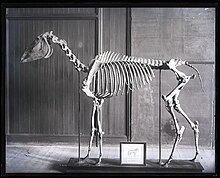
Clay trotting horses were an American strain of trotting horse during the 19th century that is no longer existent, but has descendants in the Standardbred.

Clay trotting horses were an American strain of trotting horse during the 19th century that is no longer existent, but has descendants in the Standardbred.
In 1818 Richard B. Jones, the American Consul in Tripoli, acquired a stallion named Grand Bashaw. Grand Bashaw was the sire of Young Bashaw, who in turn sired Andrew Jackson, which became noted as a trotting racehorse. [1] From a mare named Old Surrey or Lady Surrey, Andrew Jackson sired Henry Clay, who became the foundation sire of the Clay strain. [2]
The Smithsonian says this about him:
Old Henry Clay, often called "America's National Thoroughbred Trotting Horse" or "Father of American Trotting Horses", was foaled on Long Island in 1837 and purchased by Colonel William W. Wadsworth of Seneso, Livingston County, New York. When his days as a famous trotting horse were over, he was used for breeding and finally died at Lodi, New York in the spring of 1867. In life the horse stood 151⁄4 hands high (61 inches). [3]
The Clays were recognized as a family of trotting horses in the mid-19th century, [4] through to the end of the century. [5] By the end of the century, however, it had almost become extinct, through breeding to other strains. Sometimes they were referred to the Bashaw strain. [6]
Among his descendants was a trotting horse stallion named Cassius Clay. Randolph Huntington, a horse breeder, noticed after the American Civil War that Clays were becoming increasingly rare.
Writing to a friend on Nov. 2, 1888, Huntington said,
"I know the horse [Henry Clay] thoroughly well and also his get. Residing in Brooklyn I knew also the horses there and on Long Island ... practical experience in handling and driving as a young man, as a matured man and as a dealer during and after the [Civil] war, I found my opinions in favor of the blood advocated. My investment was between $40,000 and $50,000."
In 1877, Ulysses S. Grant, who was traveling in modern-day Turkey, was given two stallions by Abdul Hamid II, the Sultan of the Ottoman Empire. These two horses were Linden Tree, a Barb and Leopard, an Arabian. [7]
Randolph Huntingdon bred a number of Clay trotting mares to Grant's two stallions and used the resulting foals in his breeding program, which he called "Clay horses" or "Clay-Arabs". [8]
The following quotation is also taken from the Oyster Bay Pilot:
We have the effort of Mr. Randolph Huntington to establish a type by mixing the blood of General Grant's Arab stallions with the mares of the Clay family. It will be recalled that when General Grant made his famous tour of the world he stopped at Constantinople, and was entertained by the Sultan, who gave the American soldier, as a souvenir of his visit, two stallions, Leopard and Linden Tree. These horses were landed in 1879, and Mr. Huntington at once began making arrangements to breed to them. Mr. Huntington has theories as to in-breeding, or close breeding, as he prefers to call it, that are more in consonance with the ideas that prevail abroad than here. Of interest to the sports enthusiast is the record of one Clay stallion with the name Cassius. Although extinct now, the Clays did contribute to the creation of another American breed, the Standardbred Trotting Horse.

Horse breeding is reproduction in horses, and particularly the human-directed process of selective breeding of animals, particularly purebred horses of a given breed. Planned matings can be used to produce specifically desired characteristics in domesticated horses. Furthermore, modern breeding management and technologies can increase the rate of conception, a healthy pregnancy, and successful foaling.

The Standardbred is an American horse breed best known for its ability in harness racing, where members of the breed compete at either a trot or pace. Developed in North America, the Standardbred is recognized worldwide, and the breed can trace its bloodlines to 18th-century England. They are solid, well-built horses with good dispositions. In addition to harness racing, the Standardbred is used for a variety of equestrian activities, including horse shows and pleasure riding, particularly in the Midwestern and Eastern United States and in Southern Ontario.

The Morgan horse is one of the earliest horse breeds developed in the United States. Tracing back to the foundation sire Figure, later named Justin Morgan after his best-known owner, Morgans served many roles in 19th-century American history, being used as coach horses and for harness racing, as general riding animals, and as cavalry horses during the American Civil War on both sides of the conflict. Morgans have influenced other major American breeds, including the American Quarter Horse, Tennessee Walking Horse and the Standardbred. During the 19th and 20th centuries, they were exported to other countries, including England, where a Morgan stallion influenced the breeding of the Hackney horse. In 1907, the US Department of Agriculture established the US Morgan Horse Farm near Middlebury, Vermont for the purpose of perpetuating and improving the Morgan breed; the farm was later transferred to the University of Vermont. The first breed registry was established in 1909, and since then many organizations in the US, Europe and Oceania have developed. There were estimated to be over 175,000 Morgan horses worldwide in 2005.
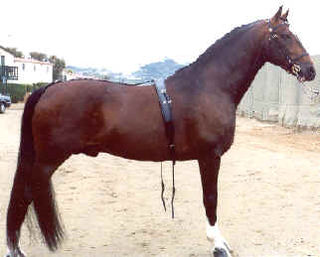
The Hackney is a recognized breed of horse that was developed in Great Britain. In recent decades, the breeding of the Hackney has been directed toward producing horses that are ideal for carriage driving. They are an elegant high stepping breed of carriage horse that is popular for showing in harness events. Hackneys possess good stamina, and are capable of trotting at high speed for extended periods of time.
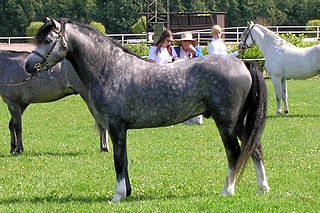
The Welsh Pony and Cob is a group of four closely-related horse breeds including both pony and cob types, which originated in Wales in the United Kingdom. The four sections within the breed society for the Welsh breeds are primarily distinguished by height, and also by variations in type: the smallest Welsh Mountain Pony ; the slightly taller but refined Welsh Pony of riding type popular as a children's show mount; the small but stocky Welsh Pony of Cob Type, popular for riding and competitive driving; and the tallest, the Welsh Cob, which can be ridden by adults. Welsh ponies and cobs in all sections are known for their good temperament, hardiness, and free-moving gaits.

Messenger was an English Thoroughbred stallion imported into the newly-formed United States of America just after the American Revolution. He is most famous for being the great-grandsire of Hambletonian 10, the father of all American Standardbred horses. Though he did not have a long racing career himself, he was a common ancestor in many successful racing horses into the 20th century.
The Colorado Ranger is a horse breed from the Colorado High Plains in the United States. The breed is descended from two stallions imported from Turkey to the US state of Virginia in the late 1800s. These stallions were then bred to ranch horses in Nebraska and Colorado, and in the early 1900s the two stallions who every registered Colorado Ranger traces to, Patches #1 and Max #2, were foaled. The breed was championed by rancher Mike Ruby, who founded the Colorado Ranger Horse Association in 1935. Original registry membership limits resulted in many Colorado Ranger horses being registered instead as Appaloosas, but pedigree research is ongoing to discover additional horses who trace their ancestry back to the original stallions.

Hambletonian 10, or Rysdyk's Hambletonian, was an American trotter and a founding sire of the Standardbred horse breed. The stallion was born in Sugar Loaf, New York, on 5 May 1849. Hambletonian has been inducted into the Immortals category of the Harness Racing Hall of Fame.

Diomed, foaled in 1777, was an English Thoroughbred race horse who won the inaugural running of the Derby in 1780. He was subsequently a successful sire in the United States.

The Orlov Trotter is a horse breed with a hereditary fast trot, noted for its outstanding speed and stamina. It is the most famous Russian horse. The breed was developed in Russia in the late 18th century by Count Alexei Orlov at his Khrenovskoy stud farm near the town of Bobrov. The Orlovs emerged as the result of crossing various European mares with Arabian stallions.

The Norfolk Trotter is a historical horse breed once native to East Anglia and Norfolk, England. It was said to be "a large-sized trotting harness horse originating in and around Norfolk".
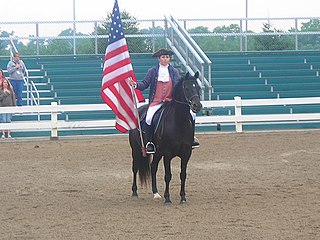
Figure was a small bay stallion owned by Justin Morgan; he became the foundation sire of the Morgan horse breed.
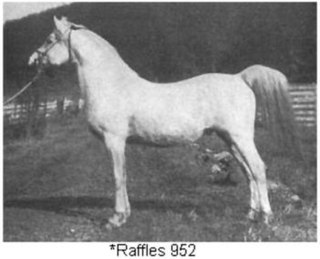
Raffles was an Arabian stallion foaled in 1926 and imported to the United States by Roger Selby in 1932. Raffles was bred by Lady Wentworth of the Crabbet Arabian Stud.

Indraff (1938–1963) was a gray Arabian stallion, foaled on May 9, 1938 and bred by Roger Selby of Ohio. His sire was Raffles and his dam was Indaia. Both his sire and dam were bred by the Crabbet Arabian Stud in England and imported to the United States by Selby.
An Austrian Warmblood is a warmblood type of horse registered with the Arbeitsgemeinschaft für Warmblutzucht in Österreich. Although the studbook is made up of jumping and dressage horses from many other countries, the mare base consists of native horses with a long history. The AWÖ keeps an open studbook, in which mares and stallions must pass rigorous inspections before becoming breeding stock.
The Tersk Stud is a horse breeding farm, and it was used to restore the Russian horse population, which suffered heavy losses during the 1917-1923 Revolution. It was officially established on 11 February 1921, on the orders of Marshal Semyon Budyonny.
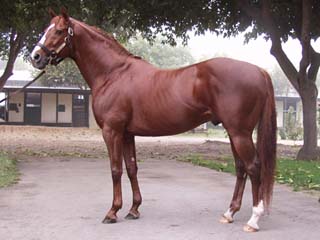
The Thoroughbred is a horse breed developed for horse racing. Although the word thoroughbred is sometimes used to refer to any breed of purebred horse, it technically refers only to the Thoroughbred breed. Thoroughbreds are considered "hot-blooded" horses that are known for their agility, speed, and spirit.
Khaled AHR# 5, often referred to as Khaled 5, was an Arabian horse that was one of the foundation horses of the Arabian Horse Registry of America. He was a chestnut stallion foaled on May 24, 1895, by the stallion *Nimr and out of the mare *Naomi. He was bred by Randolph Huntington of Oyster Bay, New York, who was noted for his efforts to promote and protect the Arabian breed. Khaled 5 was the sire of nineteen registered purebred Arabian foals.

William Robinson "W. R. " Brown was an American corporate officer of the Brown Company of Berlin, New Hampshire. He was also an influential Arabian horse breeder, the founder and owner of the Maynesboro Stud, and an authority on Arabian horses.

Black Allan or Allan F-1 was the foundation sire of the Tennessee Walking Horse. He was out of a Morgan mare named Maggie Marshall and by Allendorf, a stallion descended from Narragansett Pacer, Canadian Pacer, and Gaited Spanish Mustang imported from Texas. Black Allan was registered as No. 7623 by the American Trotting Registry. Although Black Allan was supposed to be a trotter, he preferred to pace and so never raced. Besides the pace, he performed a lateral ambling gait now known as the running walk. He was a black stallion standing 15 hands, 5 feet high. He was given the designation Allan F-1 when the Tennessee Walking Horse Breeders' Association, precursor to the Tennessee Walking Horse Breeders' and Exhibitors' Association, was formed in 1935. He had multiple owners throughout his life, but his last owners, James Brantley and Albert Dement, were the only ones to recognize Black Allan's use as a breeding stallion. Black Allan sired 111 known foals in his lifetime, among them Roan Allen, registration number F-38, Hunters Allen F-10, and Merry Legs F-4. Black Allan died September 17, 1910, at the age of 29.